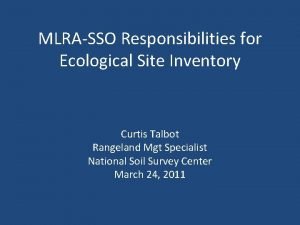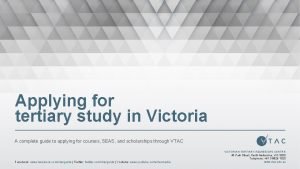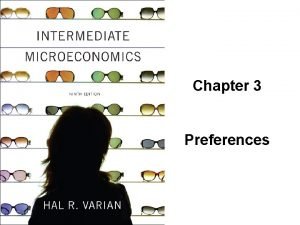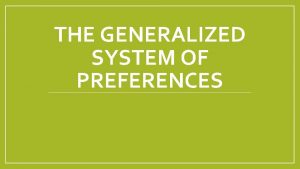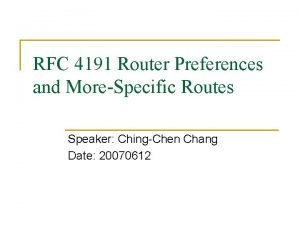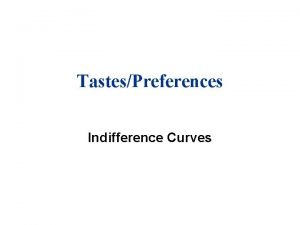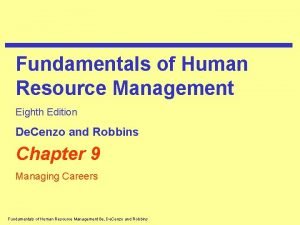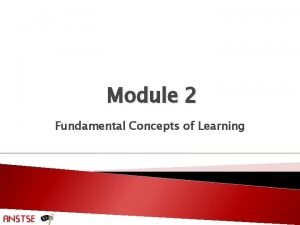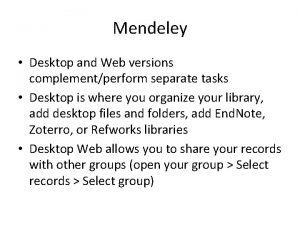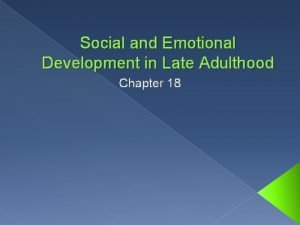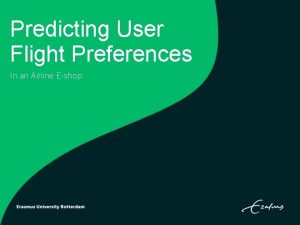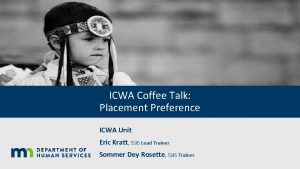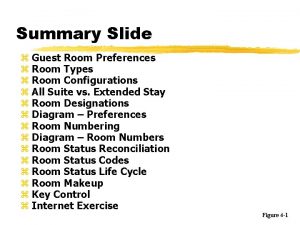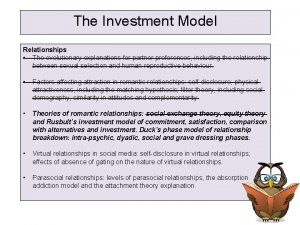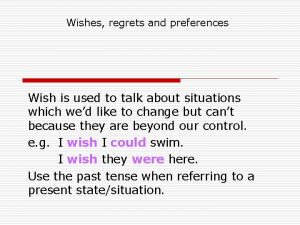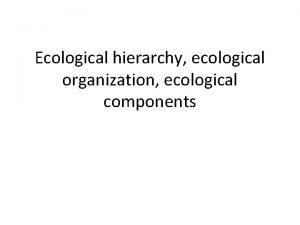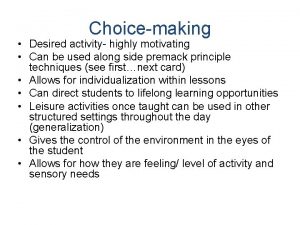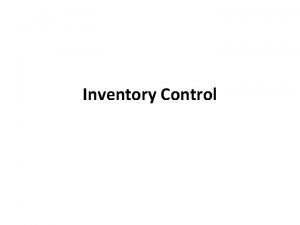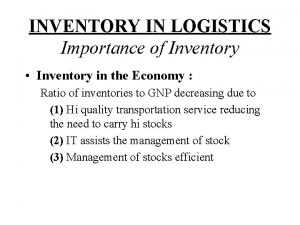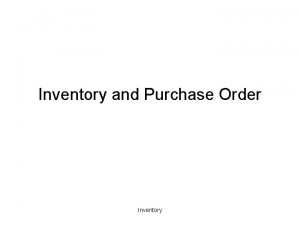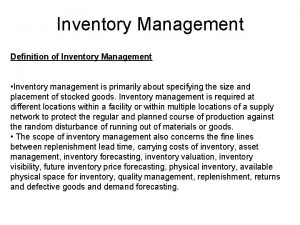Week 4 Assessing Preferences Choicemaking Update Ecological Inventory




















- Slides: 20

Week 4: Assessing Preferences & Choice-making Update – Ecological Inventory & Article Review #1 Due Today – Preference Assessment is Due on April 25 th(we will go over the template and example today) – Task Analysis on Functional Skills Due May 2 nd Today’s Agenda – Entry Activity & Quick Review – In-Class Activity on Preference Assessment

Entry Activity Partner with someone who reviewed a different article than you. Complete the entry activity questions Be ready to share about the intervention and how you may use this intervention in your teaching.

Planning for paraprofessionals One of the keys to good teaching is good planning p Daily & weekly schedule of activities indicating what, when, who, where p Parapros schedule should be linked to classroom schedule p n p Should be clear what they should be doing for each activity in class Develop plans that provide the content and level of info required for them to carry out the plan

Steps in Ecological Assessment Process? ? ? • Step 1: Plan with Student & Family • Step 2: Summarize what is known about the student • Step 3: Encourage Self-Determination/ Assess Student Preferences • Step 4: Assess student’s instructional program • Step 5: Develop ecological assessment report

Briefly Share your Ecological Inventory with a Partner • What did you learn from doing this? • How will this information guide further assessment or instruction for the student?

Steps in Ecological Assessment Process? ? ? • Step 1: Plan with Student & Family • Step 2: Summarize what is known about the student • Step 3: Encourage Self-Determination/ Assess Student Preferences • Step 4: Assess student’s instructional program • Step 5: Develop ecological assessment report

Step 3: Encourage Student Self. Determination/ Assess Preference • Strengthen the student’s influence on their education • Student may need to try new options through systematic preference assessment (Lohrmann. O’Rourke & Browder, 1998) – Note student’s typical choices, talking with others who know the student, & new options – Student preference enhanced by offering & honoring choices (Kern et al. , 1998)

Review the Lohrmann-O’Rourke et al. article with a partner & answer these questions: 1. Identify the three reasons preference assessments are used. 2. State the strategies discussed by the authors for determining preferences 3. Define the difference between single stimulus presentation, paired stimulus presentation, & group presentations 4. What do the authors recommend for identifying a response during a preference assessment?

Steps in Conducting a Systematic Preference Assessment 1. 2. 3. 4. 5. 6. 7. 8. Define the purpose of the assessment. Select the range of sampling options Determine the forms of the sampling options Define the student’s responses for preference and non-preference of options Outline presentation procedures Determine sampling schedule & location Observe & record responses to options Summarize & make recommendations based on assessment.

1. Define the purpose of the assessment • Planning for the immediate context – Provide the focus person with the opportunity to become familiar with the range of options available in the daily routine of a person without disabilities • Planning for lifestyle enhancement – Major life decisions, exposure to experiences • Planning Instruction & intervention – Identify things that will reinforce behaviors • Guiding question should be: “How will this information be used to promote the student’s self-determination? ”

2. Select the range of sampling options • Consider the category based on the purpose: – Foods, drinks, tangibles, formats, job types (e. g. , clerical, custodial, etc. ) • Within that category determine the options (must be meaningful) – Applesauce, mandarin oranges, yogurt, etc. – Tasks within a job: photocopying, shredding, etc. – Graphic organizers, cloze strategy, partners

3. Determine the forms of the sampling options • Options can be either presented in their actual forms or represented with symbols or objects – Pictures (of them doing the job) – Video tape clips – A portion of the actual activity – Menu – Flyer

4. Define the student’s responses for preference and non-preference of options Discrete responses -e. g. , approaching, engaging, initiating Multicomponent responses -e. g. , manipulatin for at least 30 seconds plus sustained eye contact for at least 15 seconds, plus positive vocalizations while manipulating them. Define both positive response (indicating preference) and negative response (indicating non-preference)

5. Outline presentation procedures • Provide step by step instructions of how to present the options to the student • Define whether you will use – Single item presentation (e. g. , going to the movies) – Paired-item presentation (e. g. , markers or crayons) – Group presentations (three or more options, remove item selected, offer remaining options, represent to determine hieararchy)

6. Determine sampling schedule & location • Want to present options within the most natural setting • Determine when the options will be presented: – Massed in brief trials • When the learner is familiar with the items available – Distributed across the day • e. g. , different types of materials for instruction – Combination of massed and distributed • Narrowing job interests to schedule job tryouts – Specifically scheduled events • Touring housing options with a realtor • Important to note who presented the options

7. Observe & record responses to options • Record the responses of the student – Indicate the percentage an option is selected AND/OR – Indicate how long student engaged with option AND/OR – Hierarchy of preferences

8. Summarize & make recommendations based on assessment • See example • Want to ensure that the language is parent and teacher friendly. • Make sure the purpose is expressed and the outcome is clearly described.

Work with a partner to determine what you are thinking of doing with your target student

Specialized Techniques • Still waiting for others to turn in the Disability Matrix Activity so I an scan and post • Ability awareness Lesson Plan Due April 25 th • OT/PT observations AND AT/AAC observations not due until May 16 th & 23 rd, but be planning for these! • Annotated Bibliography: Think of a topic that sparks your interest based on our readings, discussions, etc.

Video example of Ability Awareness
 Is an alternative of log based recovery.
Is an alternative of log based recovery. Ecological inventory template
Ecological inventory template Week by week plans for documenting children's development
Week by week plans for documenting children's development Vtac preferences
Vtac preferences Well-behaved preferences
Well-behaved preferences Gsp wto
Gsp wto Rfc4191
Rfc4191 Well behaved preferences
Well behaved preferences Claims of fact
Claims of fact How do you save panel locations and visibility preferences?
How do you save panel locations and visibility preferences? Career choices and preferences in hrm
Career choices and preferences in hrm Types of learning styles
Types of learning styles Mendeley desktop preferences
Mendeley desktop preferences Peck's theory of ego integrity
Peck's theory of ego integrity Flight preferences
Flight preferences Tisc preferences
Tisc preferences Icwa placement preferences
Icwa placement preferences Platform for privacy preferences project
Platform for privacy preferences project Guest room preferences
Guest room preferences Rusbult's investment theory
Rusbult's investment theory Regret past tense
Regret past tense

